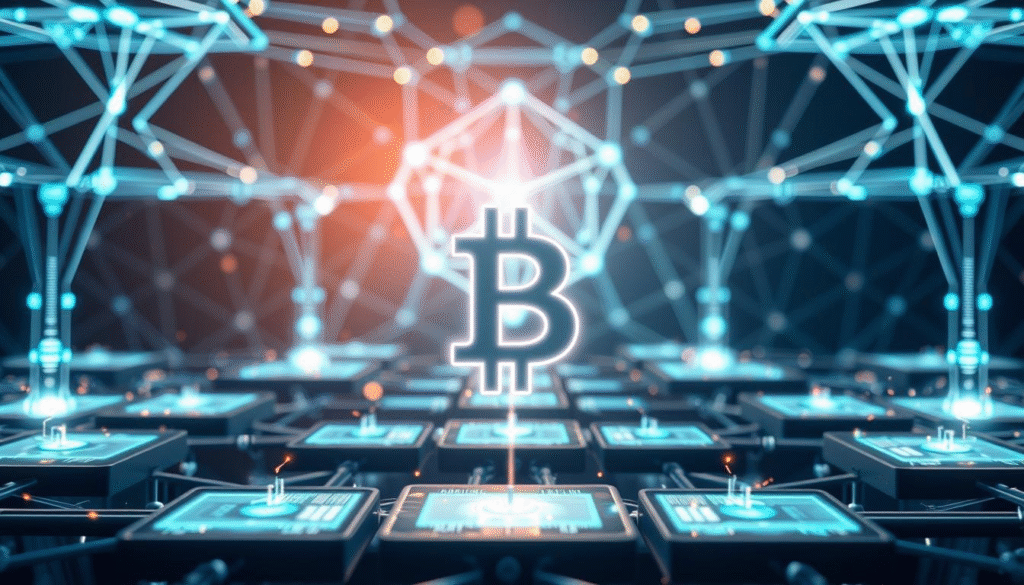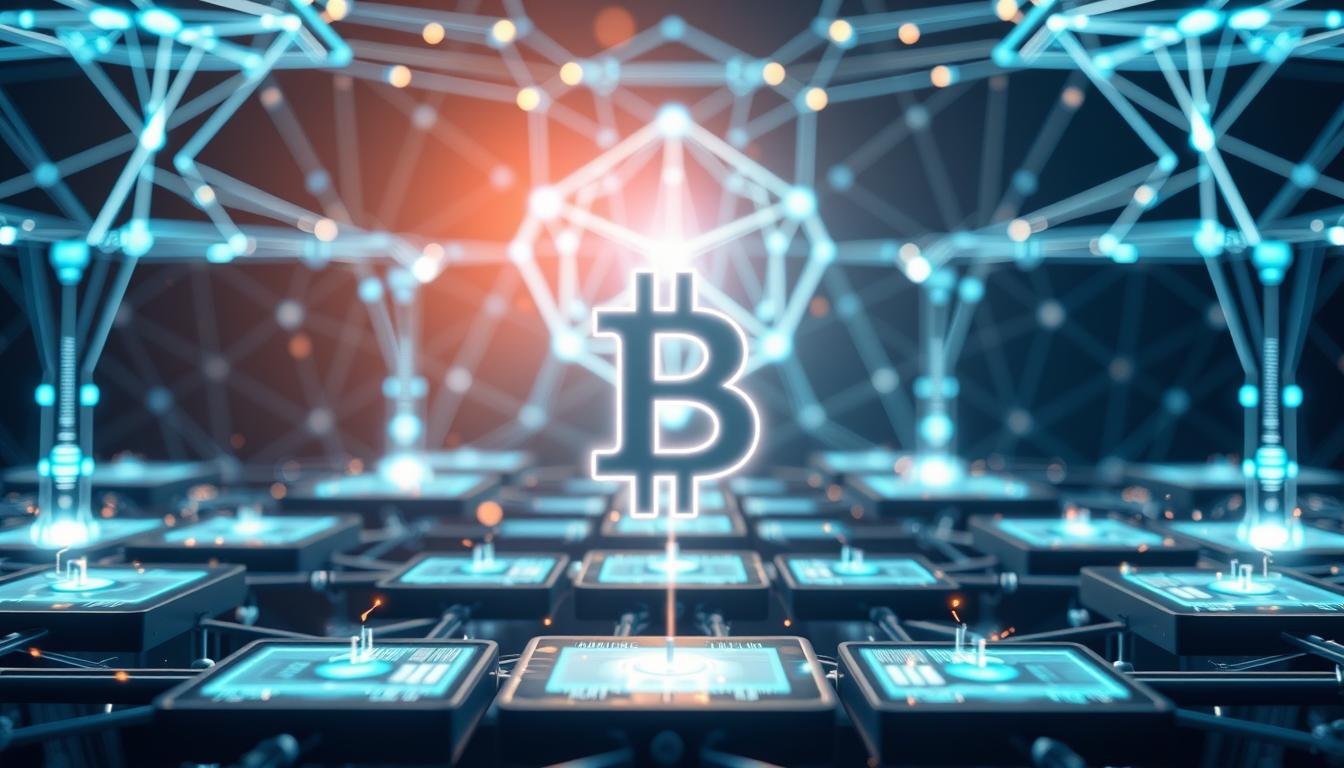The financial world is changing fast, with DeFi leading the way. Did you know that over $100 billion is now locked in DeFi protocols? This shows a big move towards decentralized finance.

Blockchain technology is key to this change. It makes transactions safe, clear, and direct. As we dive into DeFi, we’ll see how it can change money management. We’ll also guide you through this new financial world.
Key Takeaways
- Understanding the basics of DeFi and its significance
- Exploring the role of blockchain technology in DeFi
- Learning how to navigate DeFi platforms and protocols
- Discovering the benefits and risks of DeFi
- Getting started with DeFi: a step-by-step guide
Understanding Decentralized Finance
DeFi is changing how we think about money. It offers a new way to handle finances that’s open and clear. This system uses blockchain and cryptocurrency for direct transactions, cutting out middlemen.
What Is Decentralized Finance?
DeFi is a new financial system based on blockchain and cryptocurrency. It lets people lend, borrow, and trade without banks. This gives users more control over their money.
How DeFi Differs from Traditional Finance
DeFi works differently than old-school finance. It uses a network without banks, saving money and time. This makes it easier for people all over to use.
The Core Principles of Financial Sovereignty
Financial sovereignty is key in DeFi. It means people can handle their money without big banks. Smart contracts and DApps on blockchain make this possible.
Learning about DeFi helps us see a fairer, more open financial world. It’s a chance for everyone to manage their money better.
The Technology Behind Decentralized Finance
DeFi is built on blockchain technology, smart contracts, and decentralized applications (DApps). These technologies make DeFi secure, transparent, and efficient.
Blockchain as the Foundation
Blockchain technology is DeFi’s core. It’s a decentralized ledger that records transactions on a network of computers. This makes transactions secure, transparent, and tamper-proof.
Smart Contracts: The Building Blocks
Smart contracts are self-executing contracts with terms written in code. They automate processes like lending and borrowing, cutting out intermediaries.
Decentralized Applications (DApps)
Decentralized applications (DApps) run on blockchain networks. They make blockchain easy for users to interact with. DApps are key for DeFi, providing access to financial services.
Popular DeFi Protocols
Protocols like Uniswap, Compound, and Aave are big in DeFi. They offer new financial services to users.
| Protocol | Description | Functionality |
| Uniswap | A decentralized exchange (DEX) protocol | Enables users to swap tokens |
| Compound | A lending and borrowing protocol | Allows users to lend and borrow assets |
| Aave | A decentralized lending protocol | Offers flash loans and other lending services |
Getting Started with DeFi: Essential Steps
Starting your DeFi journey involves a few key steps. It’s important to understand the basics to secure your financial future.
Setting Up a Digital Wallet
A digital wallet is your entry into DeFi. It lets you safely store, send, and receive digital assets. You have to pick between a software wallet and a hardware wallet.
MetaMask Setup Guide
MetaMask is a well-liked software wallet that works with your web browser. To start, download the extension, create a password, and save your seed phrase. Remember, losing your seed phrase means losing access to your wallet.
Hardware Wallet Options
For better security, think about a hardware wallet like Ledger or Trezor. These keep your private keys offline, safe from online dangers. To use them with DeFi, connect them to your computer or mobile.
Acquiring Cryptocurrency
To join DeFi, you need to get cryptocurrency. You can buy Ethereum (ETH) or Bitcoin (BTC) on sites like Coinbase or Binance. Make sure to use a trusted exchange to avoid scams.
Connecting to DeFi Platforms
With cryptocurrency, you can connect to DeFi platforms. Sites like Uniswap, Aave, and Compound are popular. To link up, connect your digital wallet to the platform with a Web3 provider like MetaMask.
Security Best Practices
Security is critical in DeFi. Use strong passwords, enable two-factor authentication, and watch out for phishing scams. Check your wallet and platform connections often to keep them safe.
“The key to successful DeFi participation is not just about making money, but also about protecting it.”
By following these steps and focusing on security, you can confidently explore DeFi. This will open up new financial possibilities for you.
Key DeFi Services for Money Management
In the DeFi world, users can use many services to control their money better. These include decentralized exchanges, lending and borrowing platforms, yield farming, and stablecoins. Each service is important for the DeFi ecosystem.
Decentralized Exchanges (DEXs)
Decentralized exchanges let users trade cryptocurrencies without middlemen. Uniswap is a top DEX known for its liquidity and wide token selection.
How to Execute a Swap on Uniswap
- Connect your digital wallet to Uniswap.
- Select the tokens you wish to swap.
- Review the transaction details, including the exchange rate and slippage.
- Confirm the transaction and wait for it to be processed on the blockchain.

Lending and Borrowing Platforms
Lending and borrowing platforms let users lend to earn interest or borrow by providing collateral. Aave is a leading lending protocol with various options.
Step-by-Step Guide to Using Aave
- Deposit assets into Aave to earn interest.
- Use deposited assets as collateral to borrow other cryptocurrencies.
- Manage your loan-to-value ratio to avoid liquidation.
Yield Farming and Liquidity Mining
Yield farming means providing liquidity to DeFi protocols for rewards, often in more tokens. It can be profitable but also risky, like impermanent loss.
| Platform | Reward Type | Risk Level |
| Uniswap | UNI tokens | Medium |
| Aave | AAVE tokens | Low |
| Curve | CRV tokens | High |
Stablecoins for Stability
Stablecoins are tied to traditional currencies like the US dollar to lower volatility. They’re good for saving, payments, and as a market hedge.
By using these DeFi services, people can manage their money in a decentralized way.
How to Earn Passive Income with DeFi
The DeFi world offers many ways to earn passive income. It suits different investment styles. This section will look at how you can make money passively with DeFi.
Staking Digital Assets
Staking digital assets is a common way to earn passive income in DeFi. It means locking up your cryptocurrencies in a staking pool or validator node. This helps the blockchain network run smoothly.
Benefits of Staking:
- Earn staking rewards in the form of additional tokens
- Support the security and operation of blockchain networks
- Potential for long-term capital appreciation
Choosing the Right Staking Platforms
When picking a staking platform, look at its reputation, staking rewards, and security. These factors are key.
Providing Liquidity to Pools
Another good way to earn passive income is by providing liquidity to DeFi pools. By adding assets to a liquidity pool, you help with trading on decentralized exchanges (DEXs). You also get a share of the transaction fees.
Calculating Your Returns
To figure out your returns from liquidity provision, think about the trading volume, liquidity pool fees, and impermanent loss. These factors affect your earnings.
| Factor | Description | Impact on Returns |
| Trading Volume | Higher trading volume increases fees | Positive |
| Liquidity Pool Fees | Fees earned by liquidity providers | Positive |
| Impermanent Loss | Temporary loss due to price volatility | Negative |
Interest-Bearing DeFi Accounts
Interest-bearing DeFi accounts let you deposit cryptocurrencies and earn interest. It’s like a traditional savings account but in DeFi.
Automated Yield Strategies
Automated yield strategies use DeFi protocols to optimize yield farming and staking. They help maximize returns with little effort from you.
In conclusion, DeFi has many ways to earn passive income. From staking and liquidity provision to interest-bearing accounts and automated strategies. By understanding these methods and choosing the right platforms, you can increase your earnings in the DeFi world.
Managing Risk in Decentralized Finance
Decentralized finance (DeFi) is growing fast. It’s key for investors to understand and manage risks. DeFi offers new financial tools and platforms, but they also have unique risks.
Understanding Smart Contract Risks
Smart contracts are central to DeFi, automating processes without middlemen. Yet, they face risks like bugs and security issues. It’s important for investors to check smart contracts and the developers’ reputation.
Impermanent Loss Explained
Impermanent loss happens when the value of assets in a pool changes. This can lead to a loss for those providing liquidity. This loss is called “impermanent” because it’s only realized when liquidity is withdrawn.
Practical Examples and Calculations
Let’s say a pool has Token A and ETH. If Token A’s price goes up, the pool might rebalance. This could leave you with less of the more valuable Token A. For example, if you had 50% of each and Token A’s price doubled, you might end up with 25% of Token A and 75% of ETH.
The impermanent loss is the difference in value between your assets in the pool and what you’d have if you hadn’t provided liquidity.

Diversification Strategies
Diversification is key in DeFi to manage risk. By investing in different platforms and assets, you can reduce losses. This might include lending, yield farming, and stablecoins.
Insurance Options in DeFi
DeFi is seeing new insurance products. These cover risks like smart contract failures and asset theft. They offer a safety net for investors.
How to Purchase DeFi Coverage
To buy DeFi insurance, you interact with insurance protocols or platforms. It’s vital to check the terms, coverage limits, and premiums before buying.
Advanced DeFi Strategies for Wealth Building
DeFi has opened up new ways to create wealth. Advanced strategies are leading the way. Investors are looking for sophisticated methods to increase their returns.
DeFi Portfolio Management
Effective DeFi portfolio management is key in the volatile cryptocurrency market. It means regularly checking and adjusting your investments. This keeps your investments in line with your financial goals.
Leveraging Flash Loans
Flash loans are a unique DeFi feature. They let users borrow funds without collateral for a short time. They are great for arbitrage opportunities and can be very powerful.
Step-by-Step Arbitrage Strategy
- Identify price discrepancies across DEXs
- Use flash loans to borrow funds
- Execute trades to capitalize on the discrepancy
- Repay the flash loan with interest
A DeFi expert notes, “Flash loans have made arbitrage more accessible. Now, anyone can join the market.”
“The ability to leverage flash loans has been a game-changer for many DeFi investors, providing a new avenue for generating returns.”
Cross-Chain DeFi Opportunities
Cross-chain DeFi is a new area. It lets different blockchain networks interact. This opens up new chances for diversification and growth.
| Blockchain | DeFi Opportunities | Key Features |
| Ethereum | Lending, Borrowing | Smart Contract Platform |
| Binance Smart Chain | Yield Farming, Staking | Low Transaction Fees |
| Polkadot | Cross-Chain Transactions | Interoperability |
Automated Trading Strategies
Automated trading strategies help investors without constant monitoring. They are very effective in the fast DeFi market.
By using these advanced DeFi strategies, investors can grow their wealth. It’s important to stay updated and adapt to the changing DeFi world.
The Future of Decentralized Finance
DeFi is growing, and we’ll see more big investors coming in. This will bring new money and skills, leading to more innovation and growth.
Institutional Adoption Trends
Big financial companies are now looking into DeFi. They bring lots of money and knowledge. Institutional investment will make DeFi markets more stable and liquid.
Regulatory Developments
Rules for DeFi are changing. Governments are figuring out how to manage this new financial world. Soon, we’ll have clearer rules, helping DeFi projects grow.
Emerging DeFi Innovations
New ideas keep coming in DeFi. One big area is Layer2 solutions. These help make blockchain networks faster and cheaper.
Layer2 Solutions and Scaling
Layer2 solutions like Optimistic Rollups and zk-Rollups are solving scalability problems. They make transactions quicker and cheaper, reaching more people.
| Layer2 Solution | Description | Benefits |
| Optimistic Rollups | A scaling solution that batches transactions | Reduced costs, increased speed |
| zk-Rollups | A scaling solution using zero-knowledge proofs | Enhanced privacy, scalability |
Integration with Traditional Finance
DeFi is also getting closer to traditional finance. As DeFi grows, we’ll see more connections between the two. This could open up new chances for investors.

Conclusion
Decentralized finance (DeFi) is changing the financial world. It offers a new way to manage money, different from old systems.
DeFi can help more people get financial services. It makes transactions safer and more open. Some big benefits are:
- More people can use financial services.
- Blockchain makes things safer.
- Transactions are more open and honest.
- Investments might earn more.
The future of DeFi looks bright. New trends and ideas will make it even more popular. As blockchain finance grows, we’ll see more uses for it.
DeFi could change the financial world for the better. It could make money management safer, clearer, and fairer for everyone. As DeFi gets better, it will likely change how we handle our money and assets.
DeFi is exciting because it could make financial services available to more people. It’s a fast-changing field that’s worth keeping an eye on.
Sources
For more on Decentralized Finance, check out these sources. They offer great insights and info.
- CoinDesk: What is DeFi?
- DeFi Pulse: DeFi Rankings and Insights
- The Block: Crypto and DeFi Research
These links are packed with info on DeFi. You’ll find guides for beginners and deep research for experts. They help you keep learning about Decentralized Finance.
FAQ
What is Decentralized Finance (DeFi)?
DeFi is a new way of doing finance on blockchain. It lets people do financial things without needing banks. It’s all about making money transactions open and fair.
How does DeFi differ from traditional finance?
DeFi is different because it uses a network that’s not controlled by one person. It lets people trade with each other directly. And it uses blockchain to keep everything safe and honest.
What are the benefits of using DeFi?
Using DeFi can make money easier to get. It costs less and is more open. You can even make money while you sleep with DeFi.
What is a digital wallet, and how do I set one up?
A digital wallet is like a safe for your digital money. To get one, pick a good service like MetaMask. Then, just follow their easy steps to start.
What are smart contracts, and how are they used in DeFi?
Smart contracts are like digital rules that money follows. In DeFi, they help with lending and borrowing. They make sure everything is fair and safe.
What are some popular DeFi protocols and services?
Some top DeFi services are Uniswap and Compound. They help with trading and lending. MakerDAO is also big, for stable money.
How can I earn passive income with DeFi?
You can make money without working with DeFi. Try staking, providing liquidity, or using special accounts. It’s easy and can make you money.
What are the risks associated with DeFi, and how can I manage them?
DeFi can be risky, like smart contract bugs or losing money. But, you can spread out your investments. Use insurance and keep up with news to stay safe.
What is the future outlook for DeFi?
DeFi looks bright, with more big players and clear rules coming. New ideas will keep it growing and exciting.
How can I get started with DeFi?
Start by getting a digital wallet and some crypto. Then, look into DeFi services like exchanges and lending. It’s a fun and new way to handle money.
